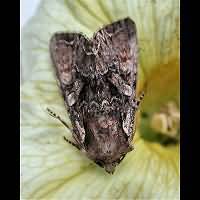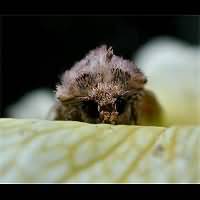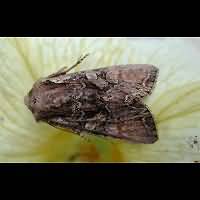Pale-shouldered Brocade Lacanobia thalassina
The Pale-shouldered Brocade is a difficult species to identify, for there are many similar species. Apparently it has a white W in the outer line, but quite some species do possess a similar W. It is best identified by the broad forewing, which has a curved leading edge. The Dusky Brocade has a less striking and duller W-shape in the outer line. The Dog's Tooth has a tooth-like marking in the central part of the forewing. The Beautiful Brocade is more marbled and more richly marked. The Dark Brocade lacks the light patches near the base of the wings. Still all these species may be very hard to tell apart, especially when they are worn out, or less well marked. In the beginning always consult an experienced moth expert when trying to label one species of this complicated group. The wingspan of the Pale-shouldered Brocade is some 38 to 44mm.
The eggs are being laid from May to September. The caterpillar may be seen all summer: from June to the end of September. It feeds by night only. During the day it sits motionless in a hiding place on the underside of a leaf or on the stem of the foodplant. Once full grown it drops to the ground, where it digs a little hole. In the hole a cocoon is made in which pupation takes place. Not only do adult Pale-shouldered Brocades have a W in the outer line of the upper wing, the caterpillars have W's all over the back, or rather joined V's. The larva itself is light brown and has a light brown head. An orange line runs over the spiracula. Above it there often is a blueish patch or blueish small line. The caterpillar is rarely seen, due to its secretive way of life. It reaches a length of some 38 to 43mm and lives on numerous plants, such as oak, birch and honeysuckle.
The Pale-shouldered Brocade is on the wing from May to late July. In the south of England and on the continent a second generation may appear in August and September. The second generation is small and does not occur every year, though. The caterpillar may be hard to find, the adult moth is less shy. Even though it only flies by night, it is happily attracted to light, sugar and blooming flowers and thus a regular visitor to gardens. Taking pictures is easy, for the animal may be handled during the day when treated carefully. A common species in most of Britain and Ireland but not recorded from the Hebrides and, curiously enough, not found on the Channel Islands either.
The Pale-shouldered Brocade is a difficult species to identify, for there are many similar species. Apparently it has a white W in the outer line, but quite some species do possess a similar W. It is best identified by the broad forewing, which has a curved leading edge. The Dusky Brocade has a less striking and duller W-shape in the outer line. The Dog's Tooth has a tooth-like marking in the central part of the forewing. The Beautiful Brocade is more marbled and more richly marked. The Dark Brocade lacks the light patches near the base of the wings. Still all these species may be very hard to tell apart, especially when they are worn out, or less well marked. In the beginning always consult an experienced moth expert when trying to label one species of this complicated group. The wingspan of the Pale-shouldered Brocade is some 38 to 44mm.
The eggs are being laid from May to September. The caterpillar may be seen all summer: from June to the end of September. It feeds by night only. During the day it sits motionless in a hiding place on the underside of a leaf or on the stem of the foodplant. Once full grown it drops to the ground, where it digs a little hole. In the hole a cocoon is made in which pupation takes place. Not only do adult Pale-shouldered Brocades have a W in the outer line of the upper wing, the caterpillars have W's all over the back, or rather joined V's. The larva itself is light brown and has a light brown head. An orange line runs over the spiracula. Above it there often is a blueish patch or blueish small line. The caterpillar is rarely seen, due to its secretive way of life. It reaches a length of some 38 to 43mm and lives on numerous plants, such as oak, birch and honeysuckle.
The Pale-shouldered Brocade is on the wing from May to late July. In the south of England and on the continent a second generation may appear in August and September. The second generation is small and does not occur every year, though. The caterpillar may be hard to find, the adult moth is less shy. Even though it only flies by night, it is happily attracted to light, sugar and blooming flowers and thus a regular visitor to gardens. Taking pictures is easy, for the animal may be handled during the day when treated carefully. A common species in most of Britain and Ireland but not recorded from the Hebrides and, curiously enough, not found on the Channel Islands either.






